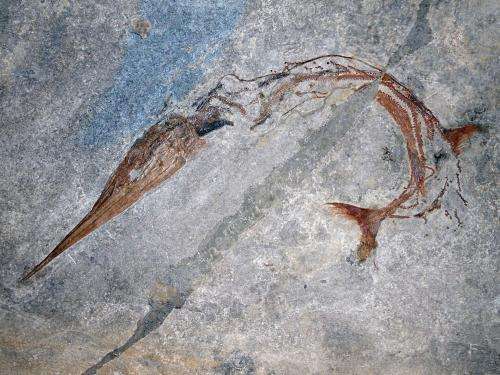Exceptional fossil fish reveals new evolutionary mechanism for body elongation

Еhe elongated body of some present-day fish evolved in different ways. Paleontologists from the University of Zurich have now discovered a new mode of body elongation based on a discovery in an exceptionally preserved fossilfish from Southern Ticino. In Saurichthys curionii, an early ray-finned fish, the vertebral arches of the axial skeleton doubled, resulting in the elongation of its body and giving it a needlefish-like appearance.
Snake and eel bodies are elongated, slender and flexible in all three dimensions. This striking body plan has evolved many times independently in the more than 500 million years of vertebrate animals history. Based on the current state of knowledge, the extreme elongation of the body axis occurred in one of two ways: either through the elongation of the individual vertebrae of the vertebral column, which thus became longer, or through the development of additional vertebrae and associated muscle segments.
Long body thanks to doubling of the vertebral arches
A team of paleontologists from the University of Zurich headed by Professor Marcelo Sánchez-Villagra now reveal that a third, previously unknown mechanism of axial skeleton elongation characterized the early evolution of fishes, as shown by an exceptionally preserved form. Unlike other known fish with elongate bodies, the vertebral column of Saurichthys curionii does not have one vertebral arch per myomeric segment, but two, which is unique. This resulted in an elongation of the body and gave it an overall elongate appearance. "This evolutionary pattern for body elongation is new," explains Erin Maxwell, a postdoc from Sánchez-Villagra's group. "Previously, we only knew about an increase in the number of vertebrae and muscle segments or the elongation of the individual vertebrae."
The fossils studied come from the Monte San Giorgio find in Ticino, which was declared a world heritage site by UNESCO in 2003. The researchers owe their findings to the fortunate circumstance that not only skeletal parts but also the tendons and tendon attachments surrounding the muscles of the primitive predatory fish had survived intact. Due to the shape and arrangement of the preserved tendons, the scientists are also able to draw conclusions as to the flexibility and swimming ability of the fossilized fish genus. According to Maxwell, Saurichthys curionii was certainly not as flexible as today's eels and, unlike modern oceanic fishes such as tuna, was probably unable to swim for long distances at high speed. Based upon its appearance and lifestyle, the roughly half-meter-long fish is most comparable to the garfish or needlefish that exist today.
More information: Erin E. Maxwell, Heinz Furrer, Marcelo R. Sánchez-Villagra. Exceptional fossil preservation demonstrates a new mode of axial skeleton elongation in early ray-finned fishes. Nature Communications, October 7, 2013. DOI: 10.1038/ncomms3570
Journal information: Nature Communications
Provided by University of Zurich




















